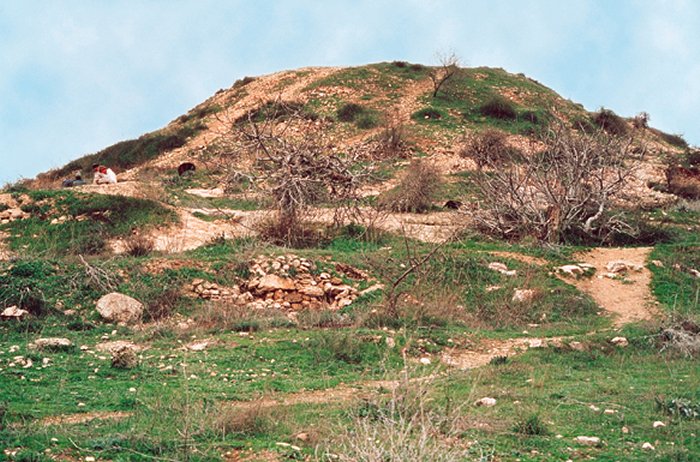Jan Bartek- AncientPAges.com – Archaeologists are trying to solve an ancient mystery and that is not easy because there are several contradicting theories.
Around Jerusalem, there are several giant mounds that were constructed for unknown reasons by builders we cannot identify. The mounds made of earth and stone are as high as a six-story building. They are estimated to be around 2,500-year-old and they simply refuse to give up their secrets. Who were the mysterious builders of these giant mounds? Why did they bother to raise such huge ancient structures?
The ancient giant mounds in Jerusalem remain an archaeological puzzle. Credit: Center for online Judaic studies.
Were these mounds used as Pagan sites or royal memorials? What is their connection to the Philistines and Biblical prophets? These are some of the questions, scientists are attempting to answer.
Under one of these artificial mounds, archaeologists discovered remains of a 2,700-year-old building and dozens of stamped jar handles. This significant archaeological discovery offered evidence the site was connected to the administration of the Kingdom of Judah in the First Temple period, but why was the building beneath the mound?
Was the Biblical administrative center deliberately hidden under stones and soil?
According to Haaretz as many as 19 artificial mounds have been discovered around the Old City of Jerusalem so far, but archaeologists who have studied these ancient structures cannot agree on the structures’ function.
Many of the mounds are in the vicinity of the Biblical Valley of Rephaim. Could the ancient structures have been constructed by giants or as a defense against extremely high and strong people?
In the Bible, there are many stories dealing with the Rephaim, a group of giants described as “a mighty people with tall stature who lived in Canaan.”
Another mysterious race that is mentioned in the Bible are the little known Didanum people, sometimes also called the Ditanu or Tidanu. The Didanum people were ancestors of the Nephilim and Rephaim.
We know that during the Middle Bronze Age, about 4,000-5,000 years ago, an unknown civilization was present in the Middle East. These mysterious ancient super-builders left behind hundreds of enormous stone structures. Who were these people? Where did they come from and what happened to them?
Can the enigmatic artificial mounds of Jerusalem be somehow connected to an unknown, giant race of builders?
Some archaeologists think there is an ancient connection between Israel’s mounds and the early Iron Age burial mounds found in Greece. In 1923, William F. Albright, one of the first archaeologists to study the site suggested after having studied pottery found at the site that the mounds were not raised by the Israelites but by invading Philistines.
Most modern archaeologists disagree with Albright’s theory. There is no evidence the mounds were used as tombs. There is also nothing that can link these huge ancient structures to the Philistines.
Ruth Amiran, an Israeli archaeologist who studied the mounds in 1953 reached the conclusion the structures were what the Bible calls “bamot” – usually translated as “high places.”
She discovered one tumulus that concealed a “retaining ring wall interrupted by a flight of a few steps. These led onto a platform that housed remains of a fire and burnt animal bones.”
Nestled today within modern neighborhoods in western Jerusalem, the mound above and 19 others were once west of the city’s populated areas. The mounds, called tumuli, were clearly manmade but their purpose has eluded excavators for over a century. Credit: Garo Nalbandian
Amiran examined ancient artifacts found on the site and came to believe the tumuli had been used as a place of worship. In an attempt to make the Israelite religion more monotheistic, the Pagan sites were later destroyed by King Hezekiah and King Josiah.
This theory is also met with skepticism by modern scientists who contradict Amiran’s argument saying that not all of the tumuli had a platform suitable for the worship of ancient gods.
Scientists think its unlikely ancient people constructed the mounds with the intention of erasing Paganism and destroying cult sites. The artificial mounds are visible from miles away and they have survived for thousands of years.
There are countless theories attempting to explain the purpose of Jerusalem’s ancient mounds, but the structures raise more questions than answers. Some have suggested the mounds were used for storage purposes. Other researchers say the structures were linked to memorial ceremonies held for deceased kings of Judah. Some scholars favor the theory the mounds were raised by the Assyrian conquerors or the local vassal kings as observation posts.
All these theories are fascinating, but they cannot fully explain the purpose of these ancient structures. At present, we simply cannot determine whether the giant mounds of Jerusalem were symbols of a conquering power, agricultural landmarks, storage facilities, places of worship, or something else entirely.
The ancient mounds are unwilling to reveal their secrets but more archaeological studies may eventually provide us with answers about the structures’ past. One day we may get to the bottom with this ancient mystery.
Written by Jan Bartek – MessageToEagle.com – AncientPages.com Staff Writer

